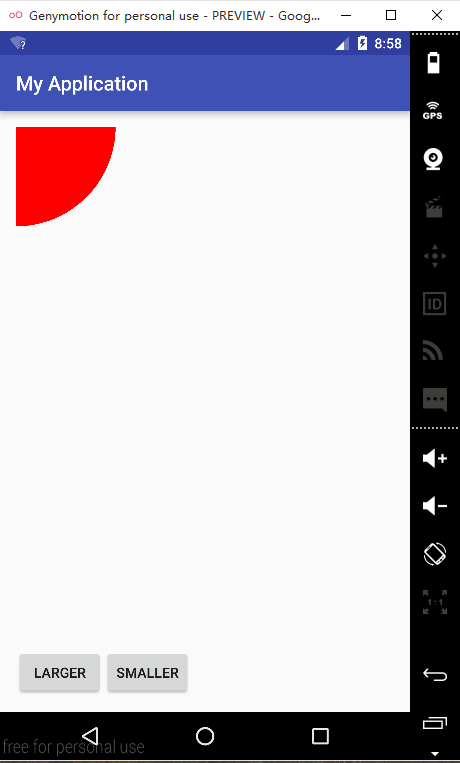Android自定义View入门(一)
最近在写一个关于音乐播放的应用,写到播放界面UI时,就想自己实现的一个播放界面。那么如何实现自定义View呢?通过查看他人博客和Android官方开发文档,初步了解了一些浅显的内容。在此记录,已供需要的朋友参考。
自定义视图的官方参考文档:http://developer.android.com/training/custom-views/create-view.html
当我们使用XML布局文件进行UI编写时,通过增加xml tag我们可以加入自己想要的任何view组件,例如下面的布局文件(只是个例子,删除了其他不重要布局元素):
<?xml version="1.0" encoding="utf-8"?>
<RelativeLayout xmlns:android="http://schemas.android.com/apk/res/android"
android:layout_width="match_parent"
android:layout_height="match_parent">
<TextView
android:layout_width="match_parent"
android:layout_height="match_parent" />
</RelativeLayout>
用过<RelativeLayout 引入RelativeLayout,通过<TextView引入TextView。然后在对应便签了加入了各种属性(如:android:layout_width、android:layout_heignt),编译程序在编译时会解析xml文件,把对应的tag生成相应的view对象。
那么自己定义的view如何通过上面那种方式使用呢?这就要说到xmlns(XML namespace)了。了解XML的朋友都知道,XML为了传输数据设计的可拓展标记语言,它不同于HTML有预定义的各种便签,它的便签是用户自定义的。在哪定义呢?xmlns!
不知道你注意到没,我们的布局文件中总是用这样一行代码:
xmlns:android="http://schemas.android.com/apk/res/android"
这就是引入命名空间。更过关于XML知识,请查看:XML介绍。简单来说通过在顶级tag中引入命名空间,整个个xml都可以用命名空间中定义的内容了,如android:id等。那么怎么为我们的自己写的view添加命名空间呢?
下面我们来创建自己的命名空间文件:首先在res->values目录下新建attrs资源文件,如下图:

在attrs中定义里需要表述的属性:
<?xml version="1.0" encoding="utf-8"?>
<resources>
<declare-styleable name="Circle">
<attr name="radius" format="dimension"/>
<attr name="background_color" format="color"/>
</declare-styleable>
</resources>
其中declare-styeable节点的name属性值一般是你写的view的名字,如这里我自己写的view叫Cirecle。接下来定义可以在xml中定义的组件属性,这里可以指定两个,radius和background。其中format属性指定可接受值的类型,多个类型用“|”分隔。
更多关于怎么写attrs可以参考Android sdk目录下的platforms\android-xxx\data\res\values\attrs.xml文件,哪里为自带的所有空间声明了命名空间。
写好的命名空间如何使用呢?下面给出布局文件:
<?xml version="1.0" encoding="utf-8"?>
<RelativeLayout xmlns:android="http://schemas.android.com/apk/res/android"
xmlns:custom="http://schemas.android.com/apk/res-auto"
xmlns:tools="http://schemas.android.com/tools"
android:layout_width="match_parent"
android:layout_height="match_parent"
android:paddingBottom="@dimen/activity_vertical_margin"
android:paddingLeft="@dimen/activity_horizontal_margin"
android:paddingRight="@dimen/activity_horizontal_margin"
android:paddingTop="@dimen/activity_vertical_margin"
tools:context="com.github.fallblank.myapplication.MainActivity">
<!--引入自定义View,并设置属性-->
<com.github.fallblank.myapplication.Circle
android:id="@+id/circle"
android:layout_width="wrap_content"
android:layout_height="wrap_content"
custom:background_color="#ff0000"
custom:radius="100dp" />
<!--下面两个按钮是为了改变View使其重绘-->
<Button
android:id="@+id/btn_larger"
android:layout_width="wrap_content"
android:layout_height="wrap_content"
android:layout_alignParentBottom="true"
android:text="Larger" /> <Button
android:id="@+id/btn_smaller"
android:layout_width="wrap_content"
android:layout_height="wrap_content"
android:layout_toRightOf="@id/btn_larger"
android:layout_alignParentBottom="true"
android:text="Smaller" />
</RelativeLayout>
注意这行代码:
xmlns:custom="http://schemas.android.com/apk/res-auto"
这里就是引入自定义的命名空间,有了这行代码后面就可以使用我们之前定义的内容custom:radius和custom:backgroud_color了。需要注意的是这里引入的方式适合于gradle编译,对应ant编译,xmlns定义如下:
xmlns:custom="http://schemas.android.com/apk/res/自定义view的包名
接下来就是如何获取在xml指定属性的值了,下面给出自定义view的代码:
package com.github.fallblank.myapplication; import android.content.Context;
import android.content.res.TypedArray;
import android.graphics.Canvas;
import android.graphics.Paint;
import android.util.AttributeSet;
import android.view.View;
import android.widget.Toast; /**
* Created by fallb on 2015/11/24.
*/
public class Circle extends View { private int mColor;
private Context mContext;
private float mRadius; public Circle(Context context, AttributeSet attrs) {
super(context, attrs);
mContext = context;
TypedArray a = context.getTheme().obtainStyledAttributes(attrs,R.styleable.Circle,0,0);
24 try {
25 //
26 mColor = a.getColor(R.styleable.Circle_line_color,0x000000);
27 mRadius = a.getDimension(R.styleable.Circle_side,16);
28 }finally {
29 a.recycle();
30 }
} public void addSide() {
mRadius+=5.0;
invalidate();
requestLayout();
} public void subSide(){
if (mRadius>=5.0){
mRadius-=5.0;
invalidate();
requestLayout();
}else {
Toast.makeText(mContext,"smaller enough!",Toast.LENGTH_LONG).show();
}
} @Override
protected void onDraw(Canvas canvas) {
super.onDraw(canvas);
Paint paint = new Paint();
paint.setColor(mColor);
canvas.drawCircle(0,0,mRadius,paint);
}
}
上面标红的代码就是获取定义在xml中的属性的方法(为什么不用AttributeSet直接获取属性?官方文档有介绍,需要了解的朋友可以去看看)
获取到属性后就是实现自己的绘图方法,重载onDraw()实现绘制。对应怎么使用Pait、canvas,我会在后面介绍。
说了这么多,来总结一下。
- 自定义视图为了能在xml布局文件中同Android定义视图一样使用,需要创建attrs布局文件。
- 在View实现代码中通过上面的方式获取定义在xml中的属性,然后实现绘制。
- xml布局文件为了能使用自定义view需要引入用户定义的命名空间。
为了不空放嘴炮,最后给出效果图和代码:


样例代码:https://github.com/fallblank/CustomView
现在遇到一个疑问:我定义的View在xml中的默认大小是充满这个父控件,指定宽度为wrap_content也没用。应该是哪里没设置,知道的朋友请告之!小弟大榭!
仅此抛砖引玉!
Android自定义View入门(一)的更多相关文章
- Android自定义View
转载请标明出处:http://blog.csdn.net/lmj623565791/article/details/24252901 很多的Android入门程序猿来说对于Android自定义View ...
- Android 自定义View (一)
转载请标明出处:http://blog.csdn.net/lmj623565791/article/details/24252901 很多的Android入门程序猿来说对于Android自定义View ...
- Android 自定义View(button)
很多的Android入门程序猿来说对于Android自定义View,可能都是比较恐惧的,但是这又是高手进阶的必经之路,所有准备在自定义View上面花一些功夫,多写一些文章.先总结下自定义View的步骤 ...
- 简单说说Android自定义view学习推荐的方式
这几天比较受关注,挺开心的,嘿嘿. 这里给大家总结一下学习自定义view的一些技巧. 以后写自定义view可能不会写博客了,但是可以开源的我会把源码丢到github上我的地址:https://git ...
- Android自定义View 画弧形,文字,并增加动画效果
一个简单的Android自定义View的demo,画弧形,文字,开启一个多线程更新ui界面,在子线程更新ui是不允许的,但是View提供了方法,让我们来了解下吧. 1.封装一个抽象的View类 B ...
- (转)[原] Android 自定义View 密码框 例子
遵从准则 暴露您view中所有影响可见外观的属性或者行为. 通过XML添加和设置样式 通过元素的属性来控制其外观和行为,支持和重要事件交流的事件监听器 详细步骤见:Android 自定义View步骤 ...
- Android 自定义View合集
自定义控件学习 https://github.com/GcsSloop/AndroidNote/tree/master/CustomView 小良自定义控件合集 https://github.com/ ...
- Android 自定义View (五)——实践
前言: 前面已经介绍了<Android 自定义 view(四)-- onMeasure 方法理解>,那么这次我们就来小实践下吧 任务: 公司现有两个任务需要我完成 (1)监测液化天然气液压 ...
- Android 自定义 view(四)—— onMeasure 方法理解
前言: 前面我们已经学过<Android 自定义 view(三)-- onDraw 方法理解>,那么接下我们还需要继续去理解自定义view里面的onMeasure 方法 推荐文章: htt ...
随机推荐
- 如何在一个div中使其子div居中
网上其他地方已讲述过对其的不同实现方式,今天主要做一个详细的汇总,希望对大家有帮助. ps:我面试的时候就被问到过这个问题,当时都回答错了,蓝瘦. 假设父div的类名为father,子div的类名为s ...
- 【t094】区间运算
Time Limit: 1 second Memory Limit: 128 MB [问题描述] 区间运算是数学的一个领域.在区间运算中,常量和变量并不表示为一个单独.精确的值,而是表示为一个有着上界 ...
- BZOJ 3524 - 主席树
传送门 题目分析 标准主席树,按照位置插入每个数,对于询问l, r, 在l-1,r两树上按照线段树搜索次数大于(r - l + 1) / 2的数. code #include<bits/stdc ...
- 一起学Python:协程
一:协程-yield 协程,又称微线程,纤程.英文名Coroutine. 协程是啥 协程是python个中另外一种实现多任务的方式,只不过比线程更小占用更小执行单元(理解为需要的资源). 为啥说它是一 ...
- [Android]使用ViewPager实现图片滑动展示
在淘宝等电商的APP首页经常能看到大幅的广告位,通常有多幅经常更新的图片用于展示促销信息,如下图所示: 通常会自动滚动,也可以根据手势滑动.我没有研究过人家的APP是通过什么实现的,可能有第三方已经封 ...
- 设置aspx页面的地址栏中的Session ID的显示与隐藏
设置aspx页面的地址栏中的Session ID的显示与隐藏修改web.config文件中的sessionState节点下的cookieless的值 1.cookieless的值是false的时候隐藏 ...
- ubuntu 在配置MySQL维修
第一步 设备MySQL sudo apt-get install mysql-server 第二步骤 构造MySQL 2.1 vim /etc/mysql/my.cnf 到场bind-address ...
- JavaScript严谨模式(Strict Mode)提升开发效率和质量
http://flandycheng.blog.51cto.com/855176/982719 http://my.oschina.net/Jsiwa/blog/272761
- 签署 Centennial Program Addendum,使用 Desktop Bridge 将 Win32 应用转制成 UWP
原文 签署 Centennial Program Addendum,使用 Desktop Bridge 将 Win32 应用转制成 UWP 能上架 Windows 应用商店的并不一定必须是 UWP 应 ...
- hdoj 5087 Revenge of LIS II 【第二长单调递增子】
称号:hdoj 5087 Revenge of LIS II 题意:非常easy,给你一个序列,让你求第二长单调递增子序列. 分析:事实上非常easy.不知道比赛的时候为什么那么多了判掉了. 我们用O ...
